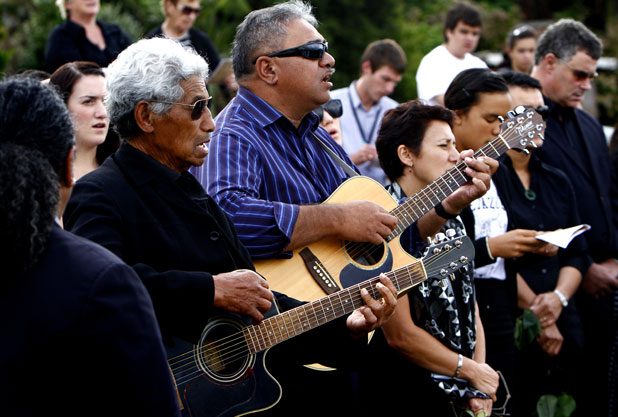The Maori in New Zealand honor those who have died with a three-day burial rite, which is becoming less commonly practiced these days, called the Tangihanga or the Tangi. The process is held at a communal and sacred place known as a marae. During the Tangi, the tribe never leaves the side of a member who has just lost a loved one. The coffins of those who have passed on are left either open on the porch at the marae, or inside the sacred place. The surviving loved ones constantly surround the coffin, ensuring that their beloved family member is never left alone.
“The surviving loved ones constantly surround the coffin, ensuring that their beloved family member is never left alone.”
The open coffin also allows for people to place flowers, photographs and any other means they have of communicating their love inside the final resting place of their loved one. This could be anything from stories, to jokes, to songs (or to simply let oneself cry). During the sharing of those who are grieving, the recently passed are instructed by those at the ceremony to return “home” to a mythological place where their ancestors come from: Hawaiki. The proposed method of travel for their spirit it through an underworld called “te rerenga wairua.”
“The proposed method of travel for their spirit it through an underworld…”
While those not related to the person who has died come to visit and communicate to them, it is customary for the family members to say nothing. After the burial rite of communicating is completed, the Maori use water to cleanse their hands and heads before they leave. The water ritual closely resembles similar rituals in Christianity; indeed, both religions believe water symbolizes cleansing and purification.
The vigil and time selection for the closing of lost loved ones’ coffins happen on the final night of the Tangi. The Maori then proceed with the more formal (and often religious) burial service. Water, again, plays a major role for those present once they leave the burial grounds. As a final celebration of the lost loved ones, the Maori people gather for a feast with gifts of food provided by non-family mourners. The tribe then performs a final act of cleansing as they use prayers and songs to aid the spirit of lost loved one in their departing from their former homes, as well as the location of their death.
“Water, again, plays a major role for those present…”
The tight bond between the tribe and lost loved ones does not cease after the Tangi because it is quite common for members to stay and look after the widows or widowers for several days. In this culture of New Zealand, it is reassuring to know that your friends and family will always look after your lost loved ones, surviving family members and you.
Related SevenPonds articles:

 Traditional Burial Rites for the Maori
Traditional Burial Rites for the Maori





 “Help Me, Helen”
“Help Me, Helen”
 Recovering Cremation Remains After the Los Angeles Fires
Recovering Cremation Remains After the Los Angeles Fires
 “As Tears Go By” by Marianne Faithfull
“As Tears Go By” by Marianne Faithfull














